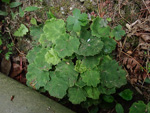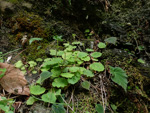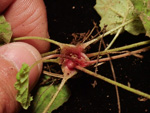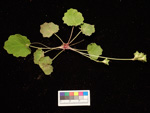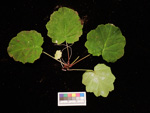Primula sinolisteri Balf.f.
Section Obconicolisteri
Link to Flora of China description
Type specimen: Forrest 4101 resides at E (specimen E00024279) and K (specimen K000750171) and P (specimen P04908538) and US (specimen US00116506) and CAL (specimen CAL0000017283).
Primula sinolisteri var. aspera W.W.Sm. & H.R.Fletcher. Type specimen: Forrest 17660 resides at E (specimen E00024812, E00024813).
Primula sinolisteri var. longicalyx D.W.Xue & C.Q.Zhang. Type specimen: D.W.Xue 200208 resides at KUN.
Primula obconica subsp. sinolisteri (syn.) (Balf.f.) W.W.Sm. & Forrest. Notes Roy. Bot. Gard. Edinburgh 16: 33 (1928).
Primula obconica var. glabrescens (syn.) Franch. Bull. Soc. Bot. Fr. 33:66 (1886) pro parte.
Primula listeri var. glabrescens (syn.) Franch. Bull. Soc. Bot. Fr. 35:428 (1888) pro parte.
Epithet: Named for its resemblance to the Himalayan species Primula listeri.
Distribution: Yunnan, China.
Primula sinolisteri was originally collected on the slopes of the Tali range and it was initially unclear as to whether it was a form of the variable P. obconica or an extreme Eastern form of the Himalayan species P. listeri. From P. obconica it differs in the septate hairs and ovate or suborbicular leaves and from P. listeri by having longer scapes and usually heteromorphic flowers. P. sinolisteri is an efarinose, finely pubescent to glabrescent species with cordate leaves broadly ovate to suborbicular, apex rounded or obtuse, sometimes acute, margin undulate-lobulate with lobules remotely hydathode-denticulate, petioles slender, wiry, often red towards the base and vaginate. Scapes to 20cm. tall, pubescent, with an umbel of 2-8 white or pink flowers, usually heterostylous, calyx broadly campanulate, short pubescent, parted to 1/3 into broadly triangular acute or apiculate lobes. Two varieties are recognized; P. sinolisteri var. aspera with homostylous flowers, petioles and scape with septate hairs and larger calyx to 1 cm. and P. sinolisteri var. longicalyx with annulate flowers, corolla glabrous outside, calyx subequal to the tube, from Wuliangshan, Jingdong.
